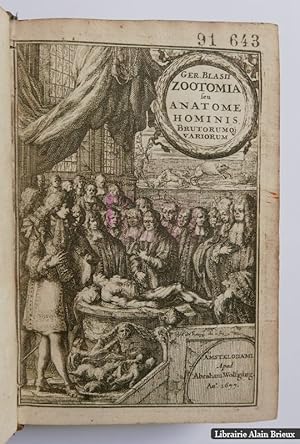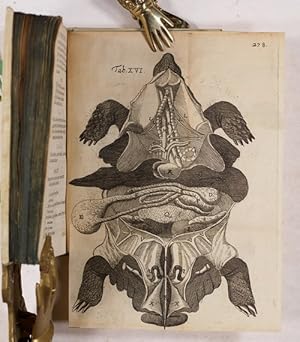BLASIUS, GERARD; BLAES, GERARD (4 résultats)
Type d'article
- Tous les types d'articles
- Livres (4)
- Magazines & Périodiques
- Bandes dessinées
- Partitions de musique
- Art, Affiches et Gravures
- Photographies
- Cartes
-
Manuscrits &
Papiers anciens
Etat
- Tous
- Neuf
- Ancien ou d'occasion
Reliure
- Toutes
- Couverture rigide (3)
- Couverture souple
Particularités
- Edition originale (2)
- Signé
- Jaquette
- Avec images (3)
- Sans impression à la demande
Pays
Evaluation du vendeur
-
Couverture rigide. Etat : Bon. titre-front., 87 (i.e. 77) Abrahmum Wolgang,Amsterdam, 1676 (1677), in-8, titre-front, 87 (i.e. 77) pp. ; et [1]-292-[4] pp, 51 (sur 53) pl. (erreur dans la pagination, qui laisse croire qu'il manquerait les 10 premières pages de la première partie), basane havane de l'époque, dos à nerfs et fleuronné, L'illustration comprend 18 planches d'anatomie comprises dans la pagination pour la première partie et 51 planches hors texte pour la seconde : un grand nombre de ces dernières ont été découpées à la cuvette. Il manque 2 planches (se plaçant aux pages 190 et 192). Gerard Blaes (? 1692) est l'auteur de trois ouvrages sur l'anatomie comparée, celui-ci étant le premier, publié à l'origine en 1673 (Miscellanea anatomica. Amsterdam, Kaspar Commelijn). Ses recherches aboutiront à l'important Anatome animalium de 1681, qui est considéré comme le premier manuel complet d'anatomie comparée basé sur les recherches originales et littéraires d'un anatomiste alors en activité. La présente édition est la seconde, augmentée et ornée d'un titre-frontispice à la date de 1677. Les pages qui concernent l'anatomie comparée sont des réimpressions de l'édition originale. En tout, l'auteur décrit ici l'anatomie de 14 espèces d'animaux (tortue, canard, pigeon, boeuf, mouton, cochon, chien, chat, civette, renard, rat, lapin, lièvre et singe) ; les pages qui concernent l'anatomie du chien constituent le premier traité complet et original sur un vertébré depuis le célèbre ouvrage de Carlo Ruini sur le cheval (1598). Cachets de l'Institut catholique de Paris Reliure usagée. Cole, p. 150 et suiv. Nissen ZBI, n° 385.
-
Anatome Animalium, terrestrium variorum, volatilium, aquatilium, serpentum, insectorum, ovorumque, structuram naturalem ex veterum, recentiorum, propriisque observationibus proponens, figuris variis illustrata.
Edité par widow of Johannes van Someren, Hendrik and widow of Dirk Boom, Amsterdam, 1681
Vendeur : Sanctuary Books, A.B.A.A., New York, NY, Etats-Unis
Edition originale
Hardcover. Etat : Very Good+. First Edition. 4to. With full-page engraved frontispiece by J. Luyken, and 60 numbered and 5 unnumbered full-page engravings. Contemporary calf, rebacked. Garrison & Morton 296; Krivatsy 1339; Nissen, ZBI 381; Wellcome II, p. 179; Wood, p. 243. "The first general systematic treatise on comparative anatomy" (Garrison & Morton) and a "well known and important early treatise" (Wood).
-
Anatome Animalium, Terrestrium Variorum, Volatilium, Aquatilium, Serpentum, Insectorum, Ovorumque, Structuram Naturalem. [The Anatomy of Animals, Land, Sea, Air, Serpents, Insects. The Structure of Natural Things From Vertebrae]
Edité par Joanis á Someren / Hernrici & Viduæ Theodori Boom, Amsterdam, 1681
Vendeur : Barter Books Ltd, Alnwick, NORTH, Royaume-Uni
Membre d'association : IOBA
Edition originale
Vellum spine on marbled boards. First Edition. 290mm x 240mm (11" x 9"). [3pp], 496pp. Engraved frontis plate and sixty-five fine engraved anatomical plates. Gerard Blasius (1627-1682) - Dutch physician and anatomist. He was the eldest son of Leonard Blasius, who had worked as an architect in Copenhagen. Gerard started his studies there then moved to Leiden with his family, after his father died. Around 1655 he became a physician in Amsterdam. In October 1659 Blasius was appointed at the Athenaeum Illustre but without being paid. In the next year he became the first Amsterdam professor in medicine. This, his last work is considered the first comprehensive treatise on comparative anatomy. Heavy item - shipping supplement may apply for overseas. G : in good condition without dust jacket. Boards rubbed with edge-wear. Vellum spine age-darkened. Edge-tear to fep with some loss. Closed tear to upper edge of frontis engraving (c. 1"). Previous owner's ink inscription to fep. Contents otherwise clean and tight.
-
Zootomiae seu anatomes variorum animalium pars prima (all publ.).
Date d'édition : 1676
Vendeur : Antiq. F.-D. Söhn - Medicusbooks.Com, Marburg, Allemagne
Livre
Amsterdam, Abraham Wolfgang, 1676, Kl.8°, Mit gest. Titel (1677), (8), pp.19-87 (recte 79 pp.), 292, (4) pp., 18 ganzseitigen Kupfertafeln im Text, 53 tlw. gefalt. Kupfern, Pergamennteinband im Stil der Zeit; feines Exemplar; minimal flecki. Second extended edition with new engraved and printed title in 1676, but pp.1-288, which include the comparative anatomy, are identical in both editions! Cole, p.150 "The first comprehensive manual of comparative anatomy based on the original and literary researches of a working anatomist" (Cole). Blaes anticipated Cowper in finding the Cowper's glands, which he illustrated in his plate of the genitalia and os penis of the rat. The 85 pages devoted to the anatomy of the dog was the first comprehensive and original treatise on a vertebrate since Ruini" on the horse (1598. Cf. Garrison & Morton No.560 (1681 Ed.) Content: Hominis ; Canis ; Simiae ; Felis zibets ; Felis domesticae ; Vulpis ; Gliris ; Testudinis terrestir ; Anatis ; Columbae ; Vituli ; Agni ; Cuniculi ; Porci. Gerard Blaes or Blasius, who died in 1692 according to Nuyens, the date of his birth being unknown, published three works on comparative anatomy under his own name in 1673,1 1674 and 1681. The anonymous Observationes of the Amsterdam anatomists printed in 1667 and 1673 were partly contributed by Blasius, and some of them are claimed by him in his later publications. The first two of the works just mentioned record his own researches, but the last is largely a compilation or textbook, based on some ninety authorities and illustrated by sixty useful plates. It includes also his own results more or less revised, abbreviated or extended. In the 1673 volume Blasius describes the anatomy of the following fourteen types : tortoise, duck, pigeon, ox, sheep, pig, dog, cat, civet-cat, fox, rat, rabbit, hare and monkey. In the following year he revises seven of his previous descriptions, and omits seven, but adds new ones on the snake, heron, hedgehog, and the spinal cord and nerves of the horse. In the textbook all the preceding memoirs, except those on the monkey, cat, pig and horse, reappear with certain modifications, and a description of the dissection of a male tiger undertaken in 1677 is also printed, and for the first time. His most detailed investigations were confined to the dog, civet-cat, hedgehog, heron, tortoise and snake. In the 1681 treatise 119 types are selected for treatment, and as many as seventy-eight of them are represented in the illustrations. The number 119 is made up as follows: MOLLUSCA, 2; CRUSTACEA, 2; INSECTA, 9; ARACHNIDA, .1; PISCES, 29 ; AMPHIBIA, 3 ; REPTILIA, 7 ; AVES, 27 ; MAMMALIA, 39. Blasius is particularly interested in embryology, and deals with the foetal membranes and development of ruminants, rabbit, cat, horse and the chick. The illustrated monograph on the chick is a very careful and thorough piece of compilation, and may be recommended as a competent exposition of contemporary embryology. It is evident that the textbook was planned on a generous scale, and may be accepted as the first comprehensive manual of comparative anatomy based on the original and literary researches of a working' anatomist. It is thus a valuable introduction to the history of zootomy, since most of the relevant literature published up to that time is skilfully handled by one of the best known of its exponents. On the other hand the student must not expect to find in this work a review of comparative anatomy as it is understood to-day, or even as it was understood by the more philosophical workers of the period. In all the writings of Blasius we search in vain for any discussion or integration of the data which have been so laboriously assembled. The manual especially is a catalogue of anatomical observations, and never reaches a higher level than the inanimate records of the pure descriptive anatomist, consisting as it does of a series of independent descriptions of animal .




![Image du vendeur pour Anatome Animalium, Terrestrium Variorum, Volatilium, Aquatilium, Serpentum, Insectorum, Ovorumque, Structuram Naturalem. [The Anatomy of Animals, Land, Sea, Air, Serpents, Insects. The Structure of Natural Things From Vertebrae] mis en vente par Barter Books Ltd](https://pictures.abebooks.com/inventory/md/md17747544417.jpg)
